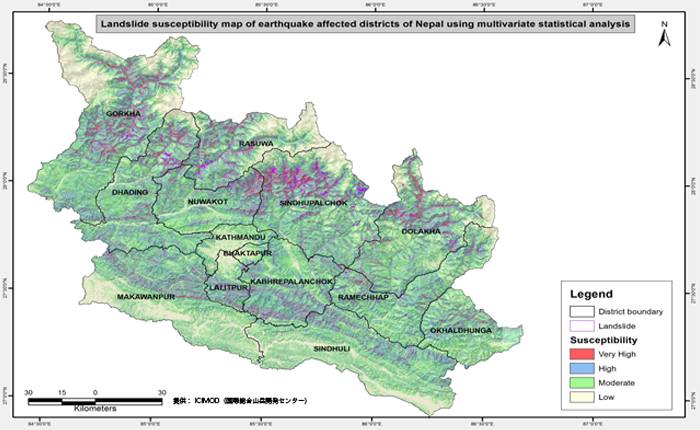
- Article
- Industry, Business, Technology
SDGs and Dynamic Capability: Future-Oriented Corporate Self-Transformation
January 21, 2020
I have spent 20 years working as a CSR officer at five Japan-based global firms spanning as many sectors: electronics, securities, pharmaceuticals, airlines, and information technology. During the course of my career, I have referred to a wide range of CSR guidelines and codes. In the past, these were overwhelmingly behavior-described approaches outlining the dos and don’ts of corporate conduct, whether in the form of conduct guidelines,[1] reporting guidelines,[2] or action platforms[3] (see Figure 1). In recent years, however, I have been working actively to align CSR management with the 17 Sustainable Development Goals of the 2030 Agenda for Sustainable Development, unanimously adopted by the UN members states in 2015. The SDGs, unlike the behavior-described approaches, place the focus on the images of society toward which we should be striving. In the process of working with the SDGs, I have arrived at some new insights, which I would like to share here.
Figure 1. Two Approaches to Achieving Sustainability
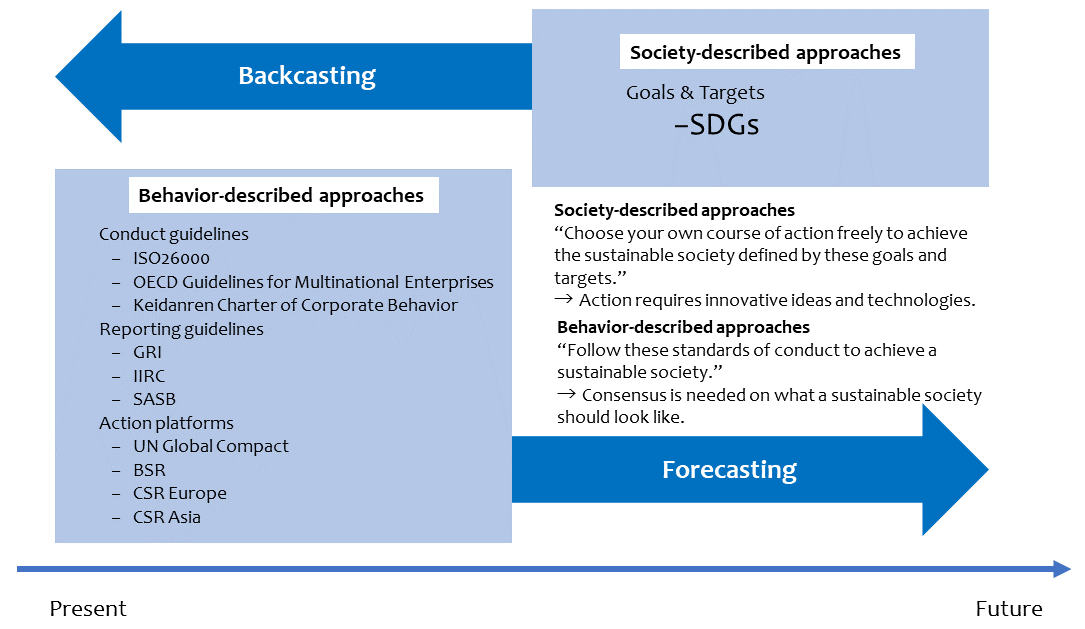
Source: Created by the author.
This is my third essay for the Foundation’s CSR White Paper. In my first, for the 2014 report, I surveyed the development of Japanese CSR from 1999 to 2014, showing how leading Japanese companies—particularly those with an overseas presence—were moving to integrate CSR into strategic management.[4] In my second, for the 2017 white paper, I discussed the impact of the SDGs on the integration of CSR from the standpoint of maintaining and creating corporate value, while stressing the importance of collaborating with nonprofit and nongovernmental organizations, given their knowledge and understanding of the social issues targeted by the SDGs.[5] Here I would like to follow up on those analyses by presenting four insights I have gained in the course of applying the SDGs in the years since their adoption in 2015 and considering their implications for future developments in the integration of CSR.
SDGs Loop
Since around 2003, when CSR took off in Japan, companies here have grappled with a dizzying procession of concepts, each accompanied by a new set of acronyms. No sooner did they learn the basics of corporate social responsibility (CSR) than they were told that the real goal should be creating shared value (CSV). Next, it was all about sustainability and ESG (environmental, social, and governance) management. And now we have the SDGs.
On the one hand, one welcomes efforts to keep the business community abreast of CSR thinking in our rapidly changing world. On the other hand, there are concerns that the need to continually shift gears and reeducate the workforce could slow the momentum of CSR activities.
Figure 2. The SDGs Loop Model

Source: Created by the author.
It seems to me, however, that the SDGs may offer a solution to this problem by making it easier to link all these CSR concepts. This is my first insight. As an example, I have developed a “loop model” with the SDGs at the apex, representing both the initial impetus and the outcome of a circular process. In the following, I will explore the “SDG loop” step by step.
Step 1. Using the SDGs to Identify Opportunities and Risks
The 2030 Agenda sets forth 169 targets divided among 17 Sustainable Development Goals. These are explained in terms of various environmental and social developments anticipated over the long term and the opportunities and risks they present. By picking out the issues and developments material to their own businesses, companies can identify opportunities and risks as part of a long-term business strategy. This is termed the “outside-in” approach to strategic management. By backcasting from an image of a brighter future, as articulated by the SDGs, companies can better understand what they need to be doing now. This is where the SDG loop begins.
Step 2: ESG Management
The next step, after identifying risks and opportunities using the SDGs, is to adopt the appropriate management policies. The three aspects of such policies are summed up in the initials ESG, standing for environmental, social, and governance. Nowadays the term ESG is most commonly used in reference to investment decisions predicated on long-term sustainability. It follows, then, that companies that want to attract and retain long-term investors need to incorporate ESG aspects in their management policies.
Step 3: CSR Activities
Corporate social responsibility is a rather general and abstract concept. However, in the Japanese context—and in my loop model—CSR refers more specifically to concrete activities that companies undertake to fulfill their responsibility to society.[6] For an overview of the types of activity subsumed under CSR, one can refer to the Seven Core Subjects of ISO 26000 (organizational governance, human rights, labor practices, the environment, fair operating practices, consumer issues, and community involvement and development) or to the closely aligned principles of the Keidanren Charter of Corporate Behavior[7] (sustainable economic growth and the resolution of social issues, fair business practices, fair disclosure of information and constructive dialogue with stakeholders, respect for human rights, relationships of trust with consumers and customers, reform of work practices and enhancement of workplace environments, engagement in environmental issues, involvement in community and contribution to its development, thorough crisis management, and the role of top management and implementation of this Charter).
Broadly speaking there are three basic approaches to CSR:[8]
(1) Provision of goods and services to resolve or mitigate social problems
(2) Socially responsible business processes (in such areas as human rights, labor practices, environmental protection, governance, compliance, and risk management) to minimize negative impacts on society
(3) Corporate philanthropy, such as the donation of assets to charitable causes
Step 4: Creating Shared Value (CSV)
The concept of CSV, or creating shared value, explains how CSR activities can benefit both the company and society.[9] In truth, a company can create shared value through any of the three approaches described above. However, Harvard University Professor Michael Porter, who developed the concept of CSV, has focused especially on the first, provision of goods and services to resolve or mitigate social problems. This approach, which leverages the market mechanism, has surged to the forefront in the age of the SDGs as a means of maximizing shared value.[10]
Step 5: Achieving Corporate and Social Sustainability
Step 5, sustainability, is the state one achieves by creating shared value. The creation of corporate value contributes to corporate sustainability, while the creation of social value contributes to the sustainable development of human society. As society becomes more sustainable, the potential for achieving the SDGs by 2030 increases, and the SDG loop is completed. However, given the obvious necessity for continuous improvement and revised targets for sustainable development, we can envision this circular process continuing ad infinitum.
We can sum up the mechanism of the SDG loop as follows: Using the sustainable development goals (SDGs) to identify opportunities and risks, companies adopt appropriate environmental, social, and governance (ESG) management policies and pursue corporate social responsibility (CSR) activities to create shared value (CSV), thereby contributing to corporate and social sustainability and the achievement of the SDGs.
At NTT Data, where I work as a senior specialist in the ESG Promotion Department, I have used this model in my in-house workshops to explain the integration of CSR into strategic management in the era of the SDGs. Raising awareness among company personnel at every level is one important key to the integration of CSR into business operations.
External Relations and Intelligence
Another important job of a CSR officer is formulating a CSR strategy. When drawing up such a plan, I use a template consisting of three performance strategies and four communication strategies, as illustrated in Figure 3. The three performance strategies correspond to the three CSR approaches explained above. The four communication strategies are the basic processes involved in the flow of CSR information:
(1) External information gathering: Keeping abreast of changes in the social and business environment
(2) Internal dissemination: Fostering awareness of the company’s CSR principles & practices among employees at all levels
(3) Internal information gathering: Monitoring the company’s CSR progress & problems
(4) External dissemination: Reporting on and publicizing the company’s CSR policies and activities
Figure 3. Framework for CSR Strategy

Source: Created by the author.
Gathering information and feedback from external stakeholders is an essential aspect of the “outside-in” approach to business strategy. The framework for the four communication strategies has engendered a second insight, namely, that application of the SDGs has the effect of enhancing a company’s external information-gathering efforts.
If my own experiences and observations over the years are any indication, Japanese companies have thus far invested very little in this process of gathering information from the outside. When it comes to CSR communication, Japanese businesses have placed top priority on disseminating information about their own CSR policies and activities externally, with an eye on the evaluations conducted by independent firms and nonprofits, the ESG investing decisions based on that information, and the sustainability rankings widely published by the media. After that comes efforts geared to raising CSR awareness among employees, followed by internal information gathering aimed at enhancing the scope and accuracy of data used for reporting purposes, contributing to external dissemination. External information gathering has tended to be an afterthought at best. Asked about their relative neglect of external information gathering, company officers have generally cited the absence of strong outside pressures, their own sense that the payoff was not worth the cost and labor involved, and the lack of perceivable downsides to such neglect.
However, attitudes are changing as understanding of the SDGs spreads and deepens.[11] Companies are strengthening their external CSR information-gathering mechanisms and processes. In addition, there are signs that CSR information gathering is evolving into a sophisticated “external relations and intelligence” capability. More and more companies are not only collecting and analyzing data regarding changes in the social and business environment but also using that information to participate in the rule-making process—either indirectly, via advocacy or lobbying activities, or directly, by gaining membership in a rule-making body.[12]
Among Japan’s CSR trendsetters, we are seeing a boom in proactive interaction with external organizations and authorities, including the following:
- Communication with global nongovernmental organizations and regulatory agencies with expertise in social issues
- Participation on the CSR committees of major economic and business organizations
- Membership and leadership positions in global organizations promoting CSR
- Top-level participation in the World Economic Forum and UN-sponsored conferences dealing with global risks and sustainability CSR issues
To take an example with which I have personal experience, NTT Data has been conducting an ongoing survey of social and technological trends expected to exert a major impact over the next 3–10 years. It uses the survey results to draw up its own technological and social forecasts, which it has been publishing annually since 2012 under the name of NTT DATA Technology Foresight (see Figure 4).[13] At NTT Data, we use these forecasts, along with the SDGs and information obtained from stakeholder dialogue, when identifying and reviewing the “material issues” that the company needs to address from the standpoint of sustainability.
Figure 4. NTT DATA Technology Foresight 2019
Source: NTT DATA Technology Foresight 2019.
Digital Transformation (DX)
The third insight is that digital transformation (DX) is essential if we are to achieve the SDGs. DX can be defined in a number of ways, but here we will adopt the definition put forth by the Japanese Ministry of Economy, Trade, and Industry, which describes it as the transformation of companies across the spectrum into “digital businesses” that make use of advanced digital technology to create new products, services, and business models.[14]
Achieving the targets of the SDGs by the year 2030 will require the use of advanced digital technology to enable the processing of massive amounts of data and sharing of information as visualized social issues, together with the knowledge to generate ideas for their resolutions and the wisdom to implement practical solutions (see Figure 5). Examples of advanced digital technology include blockchain, big data and business intelligence, cloud computing, electronic billing, open-source software, digital security and authentication, web services, infostructure design, geographic information and global positioning systems, artificial intelligence, the internet of things, and robotics.[15]
Figure 5. DIKW Framework: Leveraging Digital Technology to Address Social Issues
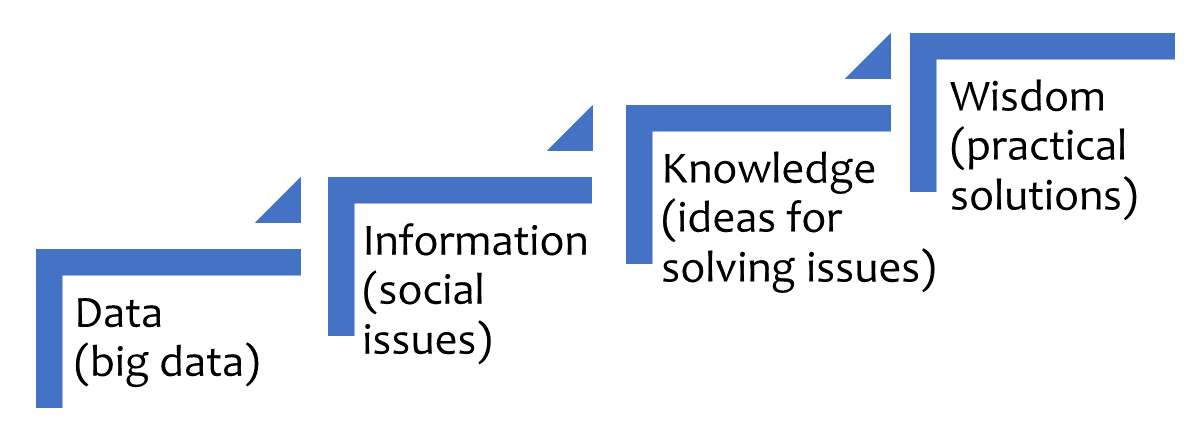
Source: Created by the author.
In a 2018 policy proposal titled “Society 5.0: Co-creating the Future,” Keidanren explains how advanced digital technology can pave the way to sustainability. “As large-scale collection, transmission, storage, and analysis of data become possible at low cost, various forms of innovation are spurred. Data enables visualization of issues and suggests solutions. Such knowledge and insights can be instantly shared around the world, leading to the resolution of management and social issues.” As examples, the report highlights the internet of things, which will enable the collection of vast quantities of high-precision performance data relevant to social issues; artificial intelligence, which will facilitate high-level analysis of the data and generate ideas for resolving the issues; robotics, which can support and relieve human beings in the execution of routine work; and blockchains, which can vastly improve transaction efficiency and traceability.[16]
Figure 6. Using Digital Technology to Address Social Issues
Source: Based on Keidanren, “Society 5.0: Co-creating the Future” (http://www.keidanren.or.jp/en/policy/2018/095.html).
In its medium-term management plan for fiscal years 2019–21, NTT Data Group has pledged to uphold its commitment to ESG management aimed at contributing to the achievement of the SDGs through its commercial transactions with clients and other corporate activities and to accelerate its digital transformation in order to deliver maximum value to clients.
Figure 7. NTT Data’s ESG Management
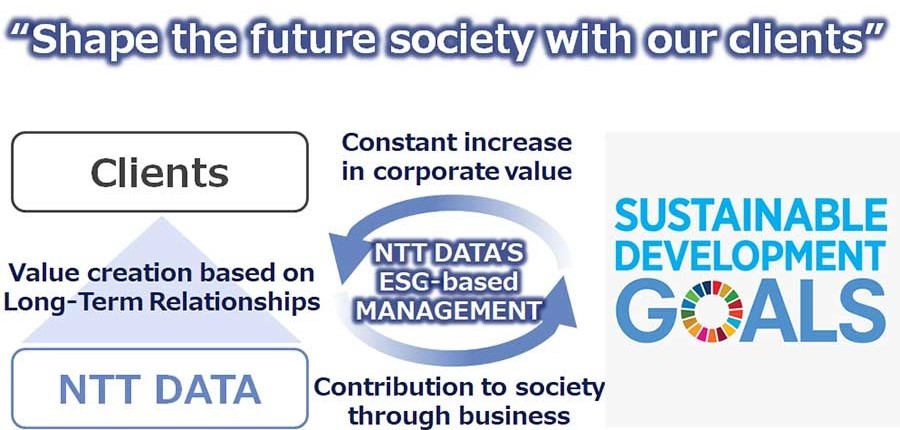
Figure 8. Three Strategies of ESG Management at NTT Data
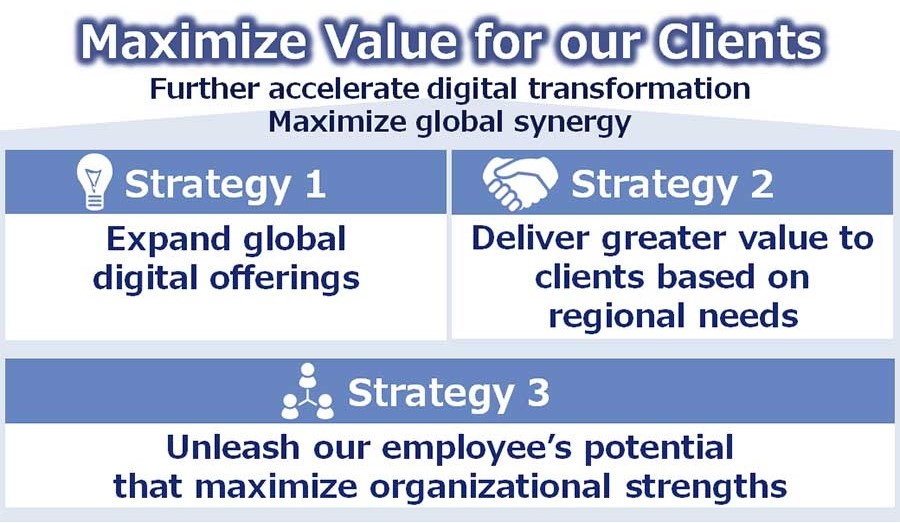
Source (for Figures 7 and 8): NTT Data, “Mid-term Management Plan (FY2019–21),” www.nttdata.com/global/en/about-us/mid-term-management-plan.
A good example of the way NTT Data is contributing to the achievement of the SDGs through its business operations is the company’s global high-resolution 3D digital mapping service, AW3D, which is already contributing to the development of solutions to a wide range of challenges, including disaster preparedness and, in the domain of public health, containment of epidemics, particularly in the developing nations of Africa and Asia.[17]
|
AW3D is the world’s first service to provide a 5-meter-resolution 3D topographic map of all the earth’s land surfaces. NTT Data developed and commercialized the mapping service in cooperation with the Remote Sensing Technology Center of Japan (RESTEC), tapping the center’s satellite imaging know-how—the product of years of development and experience—in combination with NTT Data’s high-speed, high-resolution data-processing technology. The maps are generated using satellite imageries acquired by the Advanced Land Observing Satellite “Daichi” (ALOS) of the Japan Aerospace Exploration Agency, which excels at wide-area imaging, together with ultra-high satellite images from DigitalGlobe, a US-based company that operates one of the world’s highest-resolution commercial earth observation satellites. By integrating the two, AW3D is able to generate wide-area, high-resolution 3D land maps covering the entire globe. AW3D has been applied in more than 900 projects spanning 110 countries. In Asia and Africa, in particular, it is providing developing nations with valuable solutions in the fields of geographical mapping, disaster mitigation, electric power planning, natural-resource exploration, infectious-disease control, urban planning, civil engineering, and more.
|
Dynamic Capability
I would like to conclude with some observations on the impact of the SDGs from the perspective of strategic management theory. One of the hottest areas of research in strategic management focuses on the concept of dynamic capability, developed by David Teece of the University of California at Berkeley.[18] Dynamic capability is defined as “the firm’s ability to integrate, build, and reconfigure internal and external competences to address rapidly changing environments.” It involves sensing opportunities and threats, seizing opportunities, and transforming the business by recombining and reconfiguring intangible and tangible assets.[19]
Figure 10. Components of Dynamic Capability
Source: Kenshu Kikuzawa, Seiko suru Nihon kigyo ni wa kyotsu no honshitsu ga aru (2019).
In the foregoing, I used three insights gained from the use of the SDGs in CSR management as springboards for a discussion of CSR as an integral facet of strategic management. Under the heading of the “SDGs loop,” I explained how companies can build corporate value by using the SDGs to identify opportunities and risks in the changing social and business environment. Under “external relations and intelligence,” I discussed how a focus on the SDGs is encouraging more extensive and sophisticated external information gathering and analysis and active involvement in the rule-making process. And under “digital transformation,” I pointed out the need for businesses to forge ahead with digitization if we are to resolve global sustainability issues and meet the targets of the SDGs. As it happens, these three insights are also an endorsement for strengthening businesses’ sensing, seizing, and transforming capacities, respectively. This leads to my fourth insight: The SDGs are a test of businesses’ dynamic capabilities.
The concept of dynamic capability has special relevance for CSR in the era of the SDGs, with its focus on outside-in strategic management. Now, more than ever, companies must develop the capability for self-transformation, and that transformation must be adapted not merely to changes in the immediate environment but also to the future requirements of a sustainable society. I look forward to the emergence of new research exploring the concept of dynamic capability in the context of integrated CSR in the age of the SDGs.
[1] These include the social responsibility guidance standard ISO 26000, adopted by the International Organization for Standardization (see www.iso.org/iso-26000-social-responsibility.html); the OECD Guidelines for Multinational Enterprises, published by the Organization for Economic Cooperation and Development (www.oecd.org/daf/inv/mne/48004323.pdf); and the Charter of Corporate Behavior adopted by Keidanren (www.keidanren.or.jp/en/policy/csr/charter.html).
[2] Sustainability reporting guidelines have been published by the Global Reporting Initiative (www.globalreporting.org/standards), the International Integrated Reporting Council (integratedreporting.org/resource/international-ir-framework/ ), and the Sustainability Accounting Standards Board (www.sasb.org/).
[3] Examples include the UN Global Compact and Businesses for Social Responsibility.
[4] Koichi Kaneda, “Integrating CSR into Strategic Management: A Practitioner’s Perspective,” in Tokyo Foundation for Policy Research, CSR White Paper 2014 (www.tkfd.or.jp/en/research/detail.php?id=310).
[5] Koichi Kaneda, “How the SDGs Can Benefit Japanese Businesses: Tips on Collaborating with the Social Sector,” in Tokyo Foundation for Policy Research, CSR White Paper 2017 (www.tkfd.or.jp/en/research/detail.php?id=651).
[6] In Europe, the concept of “responsible business conduct” (RBC) is increasingly being used in place of CSR. See, for example, the due diligence guidelines of the OECD and the websites of Japanese companies operating in Europe.
[7] https://www.keidanren.or.jp/en/policy/csr/charter.html
[8] For details regarding the three approaches, see my two earlier articles in the Foundation’s CSR White Paper, cited above in notes 4 and 5.
[9] A description of the value CSR activities can confer on the company and society can be found in my article, “Takeda Yakuhin Kogyo no CSR: Togo hokokusho to CSV konseputo no katsuyo,” in Mitsubishi UFJ Research and Consulting, ed., CSV keiei ni yoru shijo sozo, JUSE Press, p. 134.
[10] Professor Porter clarified his views on CSV in response to a question posed by the author at the Shared Values Forum held in Boston on May 23, 2013, stating that his aim was not to reject approach (2) and (3) as strategies for creating shared value but to call attention to the great potential of approach (1)—which taps into businesses’ inherent strengths—for creating social value with high impact.
[11] With the adoption of the SDGs by the 193 member states of the United Nations, CSR is increasingly being discussed as a matter of public policy.
[12] As a CSR officer, I have initiated participation by Japanese corporations in a number of rule-making organizations and initiatives, including BSR (see www.thinktheearth.net/jp/sp/thinkdaily/report/2000/12/rpt-01_6.html), PRI (www.daiwa-am.co.jp/company/managed/pri.pdf), Global Compact LEAD (gc-rc.org/repo/110306/110306_05.pdf), and the IIRC pilot program (sustainablejapan.jp/2014/08/13/integrated-reporting).
[13] www.nttdata.com/global/en/foresight.
[14] See METI, Report on Digital Transformation. (https://www.meti.go.jp/english/press/2018/pdf/0907_004a.pdf)
[15] NTT Data website, “Technologies,” https://www.nttdata.com/jp/ja/services/.
[16] Keidanren, Society 5.0: Co-creating the Future (http://www.keidanren.or.jp/en/policy/2018/095.html).
[17] See https://www.aw3d.jp/en/.
[18] I had an opportunity to study the concept during the year of 2017 , majoring in Sustainability Science at Hosei University’s Graduate School of Public Policy and Social Governance.
[19] See, for example, Kenshu Kikuzawa, Seiko suru Nihon kigyo ni wa kyotsu no honshitsu ga aru: Dainamikku keipabiriti no keieigaku, Asahi Shimbun Publications (2019), and David Teece’s website on dynamic capabilities, https://www.davidjteece.com/dynamic-capabilities.
